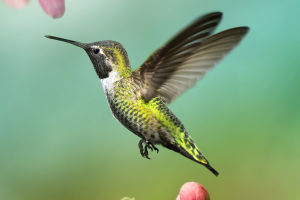Hummingbirds, a unique avian group, have captured our fascination with their dainty bodies, rapid wing vibrations, and vibrant plumage.
Revered as "flying gems" or "aerial jewels," these creatures play a pivotal role in ecosystems and stand as one of nature's most captivating marvels.
1. Physical Characteristics
Measuring merely 3 to 5 inches (approximately 7.5 to 12.5 cm) in length and weighing a mere 2 to 20 grams, hummingbirds boast a petite frame, tailor-made for flight.
Despite their diminutive size, their anatomical design is a marvel of adaptation to aerial existence.
Their wings, marvelously developed, flutter at an astonishing rate of dozens of vibrations per second, enabling them to effortlessly suspend mid-air, invert beneath flowers, and even maneuver against the fiercest winds.
The high-frequency wing vibrations are the key to their flight stability, as well as the secret behind their ability to forage nectar and insects in multifarious environments.
The feathers of hummingbirds are an exquisite palette of colors, often shimmering with iridescence.
Their metallic sheen arises from microscopic structures on the feather's surface that refract light, producing an array of colors.
This iridescence transforms hummingbirds into kaleidoscopic wonders, radiating hues such as reds, greens, blues, and purples when illuminated by sunlight.
This chromatic spectacle not only captivates observers but also aids in attracting potential mates and warding off competitors.
2. Ecological Habits
Hummingbirds are predominantly found throughout the Americas, with a particular stronghold in Central and South America.
Their habitats span diverse landscapes, including tropical rainforests, grasslands, mountain ranges, and arid deserts.
Nectar serves as their primary source of sustenance, extracted skillfully from flowers using their specialized elongated beaks.
This feeding process inadvertently exposes their faces and beaks to pollen, inadvertently fostering the pollination process that underpins the reproduction of countless plant species.
To fuel their energy-intensive flights and metabolic rates, hummingbirds necessitate substantial energy intake.
Beyond nectar, they hunt small invertebrates such as insects and spiders to obtain protein and other vital nutrients.
3. Reproduction and Behavior
Hummingbird reproduction showcases captivating behaviors. During the breeding season, male hummingbirds partake in elaborate dance and flight displays to attract female attention.
Once a successful attraction has been achieved, the pair collaboratively construct nests, with the female primarily responsible for weaving materials like plant fibers, spider silk, and insect wax.
Hummingbird nests often find a place at the junctions of tree branches, cliff faces, or even human-built overhangs. Typically, the female lays one or two eggs, followed by an incubation period of around 2 to 3 weeks.
Upon hatching, the fledglings spend several weeks developing independence from the nest, gaining the ability to fly and secure their own sustenance.
4. Conservation and Challenges
Despite their ecological significance, hummingbirds confront various threats. The degradation of their habitats, climate shifts, chemical pesticide usage, and illegal trade have all jeopardized their survival.
Of these, habitat degradation is particularly concerning, leading to dwindling populations and restricted distributions.
Safeguarding hummingbirds necessitates a multifaceted approach encompassing the establishment of protected areas, provision of suitable habitats, regulation of pesticide use, and comprehensive education initiatives.
As dainty messengers within ecosystems, hummingbirds unveil the intricate tapestry of nature through their remarkable flights, resplendent plumage, and harmonious coexistence with plants.
Yet, to ensure the enduring radiance of these celestial jewels, collective efforts are imperative to shield their habitats and mitigate multifarious threats.


